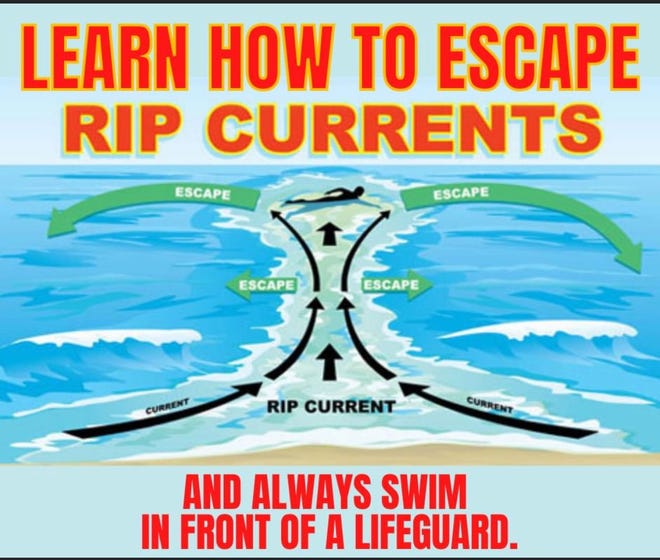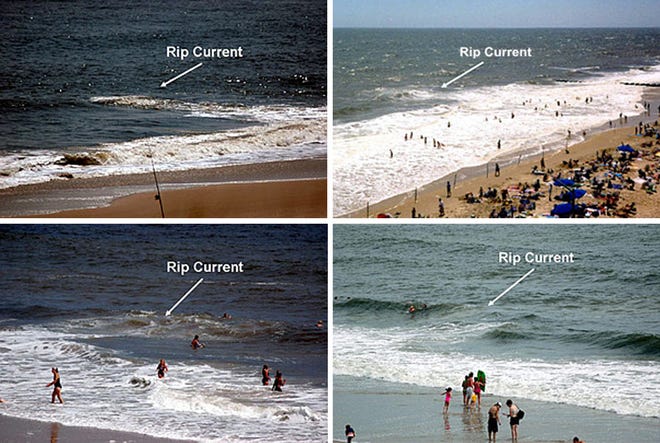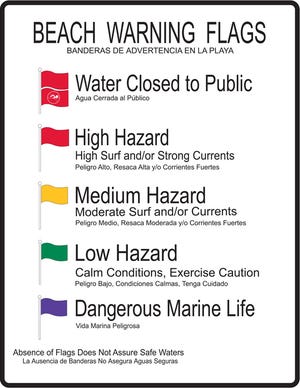2024-08-14 05:15:02
The 2024 Hurricane Season is starting to get into gear with Tropical Storm Ernesto expected to become a hurricane just over a week after Hurricane Debby made landfall in Steinhatchee and tore across North Florida. Ernesto is forecast to bring heavy rains, high winds and flooding to the Virgin Islands and Puerto Rico Tuesday night and Wednesday and then veer northward, well away from the continental United States.
But that doesn’t mean Florida won’t be threatened by the storm. AccuWeather meteorologists warn that warmer-than-usual Atlantic waters could mean rapid intensification into a major hurricane, and that could mean a dangerous risk of life-threatening rip currents along the entire East Coast toward the end of the week as swells from Ernesto impact the beaches.
“Rip currents could be very dangerous along the East coast of the United States,” AccuWeather Lead Hurricane Expert Alex DaSilva said in an email advisory Monday afternoon. “We often see rescues and loss of life at beaches during these types of storms.
“The storm may be hundreds of miles out to sea and the weather could look great at beaches along Florida, the Carolinas, even up to New England, but everyone needs to be aware of the risks and dangers at the beach,” he said. “We expect the rip current risk along the Atlantic coast of the U.S. to start later this week along the Southeast and ramp up over the weekend, expanding to the north.
“If you’re headed to the beach, please stay in areas where lifeguards are on duty.”
Will Ernesto become a hurricane?
Most likely, Tropical Storm Ernesto will become a hurricane. What that means for Florida is that East Coasters should be wary of rough surf and the potential for rain, flooding and other hazards.
The waters off some parts of the coast have been especially dangerous this year.
“Rip currents can sweep even the best swimmers away from shore into deeper water,” the NWS said. “Swim near a lifeguard. If caught in a rip current, relax and float. Don`t swim against the current. If able, swim in a direction following the shoreline. If unable to escape, face the shore and call or wave for help.”
If you or someone with you is going into the ocean, here’s what you need to know.
What are rip currents?
Rip currents are powerful, concentrated channels of water flowing quickly away from shore, most often found at low spots or breaks in the sandbar and near structures such as jetties and piers.
Rip currents form when incoming waves create an underwater sandbar. The waves push more water between the sandbar and the shore until it collapses and the water rushes back to the sea through a narrow gap, where it starts to spread out. But they can be difficult to see when you’re in the water as the ocean over them can still be smooth.
Rip currents often form during or after stormy weather but can form on bright, sunny days just as easily since the weather isn’t really what’s causing them. Rip currents can be found at any beach with waves, at any time.
What happens in a rip current?
You’re swimming along, enjoying the cool ocean water off a Florida beach, when suddenly you get knocked off your feet and feel like you’re in a rushing underwater river. You try swimming to shore but the current has you in its grip, pulling you farther out to sea.
Eventually, the current will dissipate, but not before it drags you along no matter how strong a swimmer you are. Fortunately, they’re not difficult to deal with if you keep your head.
How many people die in rip currents?
Rip currents are habitual hazards of Florida beaches. Tens of thousands are rescued from rip currents in the U.S, every year and they make up 81.9% of all surf beach rescues, according to a 2018 report from the Natural Hazards and Earth System Sciences on lifeguard data.
The United States Lifesaving Association (USLA) has estimated that over 100 people drown every year in this country due to rip currents.
How far out do rip currents go?
Sometimes rip currents end right after where the waves are breaking, sometimes they keep pulling hundreds of yards offshore. A rip current’s strength and speed can vary wildly within a matter of minutes.
How fast do rip currents move?
Rip currents usually move around 1-2 feet per second, but can speed up to 8 feet per second. That’s 5.45 mph, which doesn’t sound fast if you’re driving but is faster than Olympic swimmer Michael Phelps. The average human being tends to swim up to about 2 mph.
A rip current is typically the strongest about a foot off the bottom of the ocean floor, according to the National Oceanic and Atmospheric Administration (NOAA), which can cause your feet to get knocked out from under you and increase the feeling of being dragged along.
Can you swim away from a rip current?
While you’re in it, it can feel relentless.
Even strong, experienced swimmers caught in a rip current can easily tire themselves out trying to swim back to shore against a rip current.
What is the best thing to do in a rip current?

By far the most important thing to do is to stay calm, and even try to relax. They can be scary, but rip currents will only pull you along, they won’t pull you under the water. The biggest danger is tiring yourself out.
- Don’t panic or thrash about. Don’t bother trying to fight the current.
- You may be able to get out of the current by swimming with it parallel to the shore (or just floating or treading water) until it fades or circulates back to shore, and then you can swim to the beach.
- You also can try swimming with the current toward breaking waves, where you may be able to swim for shore.
- If you can’t reach the shore or you’re being pulled farther out to sea, or you’re getting tired, draw attention to yourself by waving or shouting for help.
What do I do if I see someone caught in a rip current?
The second biggest danger from rip currents is from people trying to rescue someone else and drowning themselves. It’s a perfectly natural impulse that may cause more harm than good. If you see someone in that situation:
- Get a lifeguard.
- If there isn’t a lifeguard nearby, call 9-1-1.
- Try to tell the victim to stay calm and swim along the shoreline.
- If it’s possible and you can do so safely, throw the victim something that floats.
What does a rip current look like?

Before you even go near the water, check the conditions. There are several ways.
- Check the forecast. The National Weather Service issues rip current statements or you can check current Florida rip current risks at weather.gov/beach/florida.
- At the beach, look for warning flags at beach approaches or lifeguard station. Red flags mean dangerous rip current activity is expected. Double red flags mean the water is closed to the public.
- Ask a lifeguard. Don’t be shy, any lifeguard would be happy to let you know if it’s dangerous to go in the water.
- Stand back where you can see the ocean’s surface and check for visible gaps of darker, flat spots in lines of breaking waves; a channel of churning, choppy water; a difference in water color; or a line of foam, seaweed or debris moving back toward the sea. But rip currents can be subtle and hard to identify, according to NOAA.
How do I protect myself and my family from rip currents?
Being aware of conditions is important, but a rip current may still catch you unaware. Here’s how to plan ahead.
- Always swim near a lifeguard, and ask one about water conditions. Teach your children to do the same.
- Assume that rip currents are out there, whether there’s a warning or not.
- Make sure that you and your family know how to swim in the surf. Being good in the pool doesn’t mean you can handle the ocean.
- Consider flotation devices for anyone who may have problems staying above water for extended periods of time.
What do the beach warning flags mean?


Watch for beach warning flags at lifeguard towers, stations and other locations for a heads-up on current conditions and potential dangers.
- Double red flags mean the water is closed to the public.
- A red flag is high hazard, meaning high surf and/or strong currents.
- A yellow flag is medium hazard, meaning moderate surf and/or currents.
- A green flag is low hazard, meaning calm conditions, exercise caution.
- A purple flag means that dangerous marine life spotted.
What is the difference between a riptide and a rip current?
Rip currents have also been called runouts, but they’re not the same as rip tides or undertow although the terms often get confused.
- Rip currents: Strong offshore currents that run along the shoreline or back out to sea.
- Rip tides: A powerful current caused by the tide pulling water through an inlet and the mouths of estuaries, embayments, and harbors. Also known as tidal jets.
- Undertow: When a wave breaks, a lot of water and sand is pulled rapidly under the surface back into the next breaking wave. Unprepared swimmers or small children can easily be tumbled around in an undertow but it only goes a short distance and only for a moment or so.





